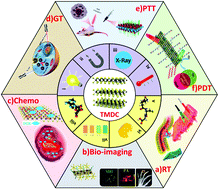Recent advances of stimuli-responsive systems based on transition metal dichalcogenides for smart cancer therapy
Abstract
Stimuli-responsive systems, which can be used for temporally and spatially controllable therapeutic platforms, have been widely investigated in cancer therapy. Among a wide range of stimuli-responsive nanomaterials, transition metal dichalcogenides (TMDCs) have recently attracted great attention due to their large surface-to-volume ratio, atomic thickness, and other unique physicochemical properties. Thus, TMDCs are able to be responsive to various endogenous (e.g. acidic pH and overexpressed enzymes) or exogenous stimuli (e.g. light and magnetic). The majority of TMDC-based therapeutic platforms are triggered by near-infrared (NIR) light. However, due to the limited penetration of NIR light, novel strategies that are able to ablate deep-seated tumor tissues have emerged in recent years and have been applied to design multi-stimuli-responsive nano-systems. A comprehensive overview of the development of stimuli-responsive TMDC-based nanoplatforms for “smart” cancer therapy is presented to demonstrate a more intelligent and better controllable therapeutic strategy. Furthermore, the versatile properties of TMDCs and the typical responsive principles of certain stimuli-responsive platforms are discussed for a better understanding of selected examples in this review.

- This article is part of the themed collection: Recent Review Articles


 Please wait while we load your content...
Please wait while we load your content...